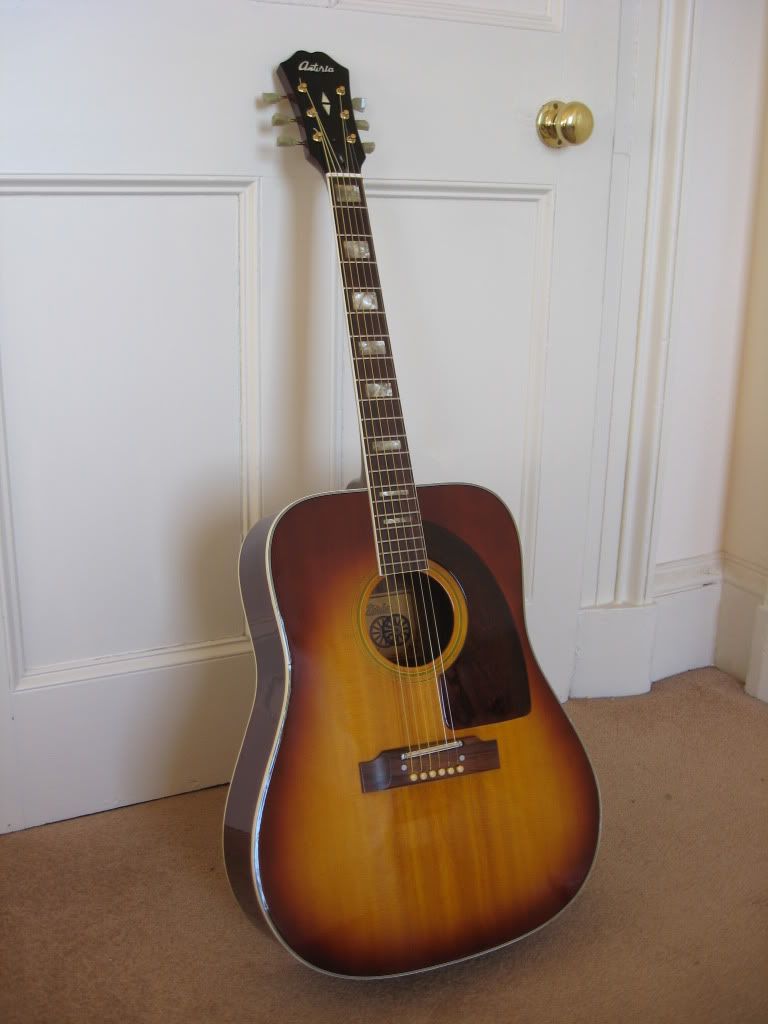These Ibanez-made Antoria acoustics were made at the FujiGen Gakki factory in Japan, which has grown to have a weighty reputation for quality, and not without reason; the fan base for guitars of many different ilks manufactured there is wide and growing. Ibanez guitars of this period are particularly well known as being modeled on famous American guitars by Fender, Gibson, Guild and Gretsch, growing to such accuracy that the lawsuit period ensued. This model i have is the F212, which is a lovely copy of the Epiphone Frontier flattop first introduced in 1958. This was an unusual model from Epiphone under Gibson control, as it was the first flattop acoustic from them to have the flat-shoulder design, which was a feature generally associated more to Martin guitars. In some ways this makes this guitar of mine quite quirky, as it has a shorter and thinner body, and shorter neck than a standard dreadnought, but larger than your normal folk or O-shaped body.
The guitar itself has a solid spruce top finished in a very tasteful vintage sunburst finish with ivory purfling, walnut back and sides, a nice short V-shaped neck with pearloid box position markers and that distinct mustachio headstock. The gold kluxon style tulip tuners are an upgrade to fall even more inline with that Frontier look, and do the job well. The saddle is a light rosewood, and sets the adjustable bridge - a terrible invention really, that was pretty popular back in the day, so in authenticity to the original, features here. In a folk guitar like this, i would be in no rush to go to the expense and hassle of changing it to a fixed bridge; the tone is crisp, quite dry and woody, more cold than warm, with good sustain, which i find quite perfect for folk country songs. One look at the guitar and you'd say it sounds exactly what it looks like it should. And it does look good.

Full set of images:
here
I haven't come across too many acoustic Antorias, which tends to make me think people keep ahold of them. One even gets the glory of featuring in the Oasis "Wonderwall" video, a J200 model. A small bit of fame.
Noddy Holder from Slade used a J200 copy in 1973 on the Cum on feel the noize Top of the Pops shows
ReplyDeletehttp://www.youtube.com/watch?v=VLsw668PVyY
and it surfaced again for the Slade in Flame era 1975. http://www.youtube.com/watch?v=Gsu_IWZ7XWU
Got a steel string acoustic guitar @ 1970s antorio , original label j t Coppock, gibson dove copy. Plays well for r+b! Consider sale.
ReplyDeleteI have an Antoria Folk guitar model 696 which l bought in the late 70s But this one has a 210 DeArmond pick up fitted which l have not seen on any of the Antoria 696 models So any info would be greatly appreciated
ReplyDeleteI got my first guitar when I was 12 years old, in 1954. It was a Christmas present, purchased from a small shop which normally sold radios and TVs, opposite my home in Stoke-on-Trent.
ReplyDeleteThe guitar was a sunburst Antoria acoustic, made in Japan. Fortunately, it played really well and sounded good. I wish I still had it, but in those days it was necessary to sell one's existing guitar to fund the next purchase.
John Egan